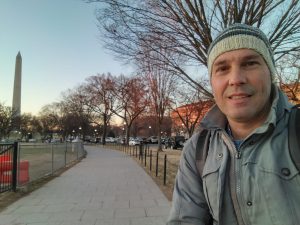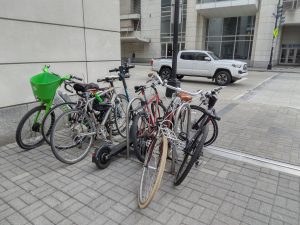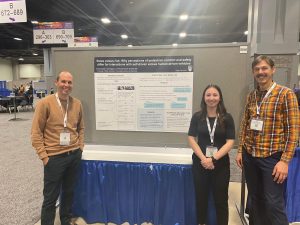
This was my first year at the Annual Meeting of the Transportation Research Board (TRB), the world’s largest transportation conference that brings over 12,000 transportation experts from industry, government and academia to Washington DC in January each year. In this post, I would like to summarize the research I shared at the conference, and distil some lessons about what I learned.
Bicycle Parking

How long are bicycles parked on city streets? Are dock-less bikeshare collapsing on-street bike parking facilities? What are the dynamics of use of bicycle parking facilities overall? The TRB allowed us to present our innovative work on bicycle parking, which has been a team effort with Victoria Ortega, Sofie Dejaegher and Esteve Corbera. To my knowledge, no one is paying attention to the use of on-street bicycle parking facilities, making our work the first to examine this question at the city scale. We found that 35% of bicycles parked on the streets of Barcelona are long-term users (1 week+) while only 12% are short-term day-users. While cities design on-street bike parking for short-term day use, in practice, at least in Barcelona, they are being used largely for long-term use. This is the result of limited or inconvenient off-street (indoor) bicycle parking in people’s homes, which then transforms on-street bicycle parking into long-term storage with limited rotation or turnover.
We document that demand for on-street bicycle parking exceeds supply in a few select locations, and since this imbalance is persistent at the same locations, it creates the perception of a generalizable undersupply of bike parking, even if parking is largely available in most other parts of the city. We see that the dock-less shared bicycles concentrate in sites visited by tourists.
People seemed to really like our methodology of using different color stickers over the course of a day to measure rotation. Simple, understandable, and effective. But it also takes a lot of person-hours to be out in the field. Looking ahead, we look forward to using the BiciZen citizen science platform that will to allow any bicycle user in the world to report bicycle parking occupancy and bicycle type in their city. The BiciZen app will be available on the Google Play and Apple Store later this month.
Deception Experiment for Self-Driving Vehicles

This year’s TRB also shared research led by the talented Masters student Emily Bardutz, in collaboration with Alex Bigazzi, Gurdil Gil and myself. This project entailed a creative, deception based, framed experiment to get at people’s perceptions of self-driving vehicles (SDV) when interacting with pedestrians. We showed research participants eight video clips of pedestrian interactions with cars in uncontrolled crosswalks. We told them that four of the clips were self-driving vehicles while the other four were human-driven vehicles (even though the were all human-driven). Emily examined the “comment box” data at the end of the survey using a regression method to infer latent topics in open text data called Structural Topic Modelling. We found that pedestrian interactions with self-driven vehicles evoke different topic comments than interactions with human-driven vehicles. Interactions with self-driven focus on rules, while interactions with HDR focus on risk. Participant comments suggested that self-driven vehicles should comply strictly with traffic rules, whereas human-driven could deviate from the rules, as long as they did it safely. Pedestrians are ascribed more responsibility to be cautious, aware, and predictable when interacting with SDV.
The paper titled Rules versus risk: Why perceptions of pedestrian comfort and safety differ for interactions with self-driven versus human-driven vehicles was forward to review in Transportation Research Record – an impressive feat since only 10% of the papers submitted are forwarded for review. Congratulations Emily and team.
Lessons from TRB
I aimed to attend all the sessions that talked about bikes. There was so much going on, I could not see it all. Here are a few reflections from my very first TRB Meeting.
- Equity is a big theme throughout the conference. There is lots of work being done to examine who benefits from transportation programs and policies. But most of this work is still quantitative, and more needs to be qualitative.
- There is a lot of work on cycling safety and bike-share but there are many other aspects of the cycling experience that does not seem to be receiving the attention it deserves. Who is working on bicycle theft? Bicycle parking? Or children and cycling? It seems that topics with lots of data are more well studied, while topics with little data, or where data is more difficult to obtain, receives scant attention.
- Alex Bigazzi made a reflection that stuck with me: There is a lot of research presented at TRB without a research question.
- The presentation by Ralph Buehler was the most interesting presentation I saw. He reviewed how cycling trends have bounced back (or not) after the pandemic. While recreational riding has increased following from the pandemic, commute cycling is down in many cities. This may be attributable to the rise of remote-work.
- Washington DC has vastly improved it’s cycling and pedestrian infrastructure. I found the city to be remarkably walkable. Bikeshare in Washington DC began in 2008, relatively early. The bikes are light and zippy, similar (or exactly) to what Bicing had in Barcelona before they became bulky and heavy.
Finally, and perhaps most importantly, I really enjoyed meeting the community. It is the people you meet that makes the conference valuable. Highlights included conversations with Calvin Thigpen (Lime), Nick Klein (Cornell), John MacAurthur (TREC at Portland State University), Stefanie Brodie (Toole Design), Celeste Chavis (Morgan State University), Kevin Fang (Sonoma State), Amanda Howell (ODOT), Hau Hagedorn (TREC at Portland State University), Rebecca Sanders (Safe Streets Research), Melinda Hanson (Brightside Strategies), Chris Cherry (University of Tennessee), and Lisa Ratner (San Francisco Bicycle Coalition).
It would have been difficult to make new connections and friends had it not been for some colleagues that made some introductions, so I am particularly grateful to Alex Bigazzi and Kelly Clifton from the University of British Columbia.
I hope that next year I can be back to present work on BiciZen and BiciBus!



